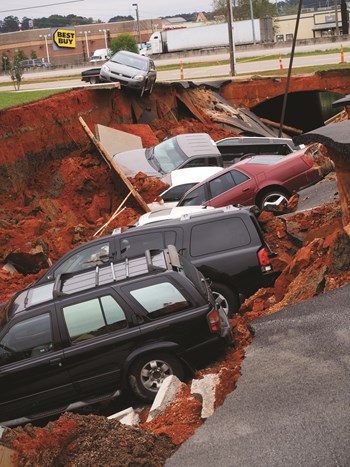
California has its landslides, the Midwest its tornadoes, Florida its hurricanes, and New Jersey has...sinkholes. They’re sort of like your own personal earthquake. There are many famous sinkholes, both large and small. The largest in the world is the Qattara Depression west of Cairo, Egypt; it measures 80 kilometers by 120 kilometers. The famous cenotes of Mexico can also be considered sinkholes; the water-filled underground caverns are sometimes open to the surface, and dot the landscape of the state of Quintana Roo on the Yucatan Peninsula.
Sinkholes can occur naturally (as in the case of the Mexican cenotes) or be man-made. They are not uncommon in New Jersey, as well as some other areas of the United States including Florida, Texas, Alabama, Missouri, Tennessee, Pennsylvania, and Kentucky. As a matter of fact, just few years ago, a sinkhole swallowed up a warehouse and showroom in Kentucky filled with classic cars.
The danger of sinkholes is proportional to their size and location, of course. If a sinkhole opens up in a remote rural area with few man-made structures and sparse population, its impact is negligible; if one should occur in the middle of Main Street in a densely populated urban area, the damage can be catastrophic – even tragic.
What is a Sinkhole?
According to the website conserve-energy-future.com, naturally occurring sinkholes “occur due to erosion or underground water. They start developing a long time before they actually appear. The ground beneath our feet is not as much of a solid structure as we think it is. It’s made up of dirt, along with many rocks and minerals. There is water continually seeping in between the mud, rocks, and minerals, [making] its way down to the ground water reservoirs. As this happens, the water slowly erodes the rocks and minerals. Sometimes the flow of water increases to a point when it washes away the underground structure of the land. And when the structure becomes too weak to support the surface of the earth, it collapses and opens up a hole. This is how sinkholes are formed.”
Human activity can also contribute to the formation of sinkholes. “Activities like drilling, mining, construction, broken water or drain pipes, improperly compacted soil after excavation work, or even heavy traffic can result in small to large sinkholes,” according to the website. “Water from broken pipes can penetrate through mud and rocks and erode the ground underneath, causing sinkholes. Sometimes, heavy weight on soft soil can result in collapse...sinkholes can also form when the land surface is changed.”
The Sinkhole State
“In general terms, there are three types of sinkholes in New Jersey. In Morris and Passaic counties, you have mining-related sinkholes,” says Gary Gartenberg, PE, a senior engineer with the Forensic Engineering and Construction Litigation Department of the Falcon Group, an engineering, architecture and energy consulting firm based in Bridgewater, New Jersey. “In the 1700s and 1800s there were in excess of 500 mines in northern New Jersey, most of which were iron mines. In the last 30 years, as sprawling development keeps pushing west, that development rolls over a town such as Mine Hill, which got its name for obvious reasons.”
That combination of hollowed-out geologic substrate, surface change, and the sheer weight of concrete, steel, and other building materials, plus human traffic, sets the scene for the near-inevitability of sinkholes appearing over time.
By contrast, Gartenberg continues, “The western part of New Jersey, near the Delaware River, has a karst topography like Florida, which is eroded limestone.” That erosion primes the area for sinkholes. “And then there are those [holes] resulting from human activity, caused mostly by things like tree stumps and cars that have been buried and that can cause depressions and shifting. You can also have collapses caused by breaks in water lines and other utility lines that undermine the ground. Approximately 85 percent of sinkholes in New Jersey result from human activity, another 10 percent from karst. The remaining five percent are the result of old mines.”
Identifying the Problem —and Repairing It
Sinkholes can occur under any type of property, including condominiums and HOAs, though Gartenberg says that the last serious sinkhole he remediated in a condominium in New Jersey was in the mid-1990s.
Regardless of the type of property affected by a sinkhole, repairing the damage can get expensive. Gartenberg sites cites one case where “the association didn’t have $150,000 to repair a sinkhole that had opened as a result of an old mine that collapsed under the parking lot.” They did use reinforced concrete slabs and grout to shore up the building next to the collapse, but they opted not to fill the hole itself. Gartenberg estimates that sinkhole repair can run anywhere from $10,000 to upwards of $4 million, depending on its cause, the size and depth of the hole, and its proximity to structures and underground infrastructure like water mains and cables.
Clearly, whether to repair or not would be a function of whether a property’s value is greater than the cost to repair the sinkhole. According to Gartenberg, in New Jersey it is the condominium association that is usually responsible for the repairs since the association owns the land under the common areas, which is where sinkholes generally occur.
Jonathan McDonald of Titan Foundation Repair Specialist LLC is a specialist in sinkhole repair and remediation based in Hernando County, Florida. McDonald says that his firm’s main method of sinkhole repair and remediation is compact grouting and underpinning. McDonald explains the process of shoring up a home or other structure threatened by a sinkhole:
“We take three-inch steel pipes called casings, and we drill all the way down to limestone [around the structure], which can lie anywhere from 40 feet to 120 feet down from the surface. We drill three feet off the wall, every 10 feet around the house. The first pipe goes in at a 90-degree angle straight down. The next pipe will be angled at 15 degrees, because we want the grout to get under the house. It goes like that all the way around the house at alternating angles. Once we are done drilling, we come out with the pump and we pump in the grout, which is a type of concrete without the rocks. By the time [the grout] reaches the limestone, it’s way down under the house, thereby supporting it. Then we extract the pipes.”
Prevention and Insurance
Given the multiple factors that can contribute to the formation of a sinkhole, is it possible to take any type of preventive measures to avoid them? Maybe – but in some cases, ‘prevention’ means avoiding building in some areas entirely, or undertaking serious pre-construction stabilization of the underlying ground. “Before you build in a mining or karst area, you should do some testing and address the condition ahead of time,” says Gartenberg. If you’re dealing with karst geology, “You use some kind of filling, flowable fill, or concrete grout to fill the void. With mining sites, it’s much more difficult because of how deep the mines can go. Some go down over 1,000 feet. So we try to fill the upper 30 or 40 feet. The difficulty is, how do you get the fill to stay at the top [as opposed to trickling down through the substrate, as water does]? It’s complicated engineering.”
When preventive steps aren’t taken—either because of the expense, or because it simply wasn’t known that a piece of land was sinkhole-prone before construction was carried out – there is insurance coverage to protect property owners and administrators from at least some of the costs associated with collapsing earth. According to TrustedChoice.com, “Many homeowner and business insurance policies offer special endorsements for sinkhole coverage. Without this additional coverage, sinkhole damage is frequently not covered [by general liability policies]. If your home or business is destroyed by a sinkhole and you do not have a sinkhole insurance policy, you may receive no compensation for your losses. You can get coverage for your vehicle simply by including comprehensive coverage with your car or truck insurance policy. This coverage will provide you with compensation for loss or damage caused by sinkholes as well as other common occurrences such as fire, inclement weather, falling objects and theft.”
Sinkhole insurance provides compensation for damages to your business or home, outlying property and personal belongings kept inside the building if they are damaged as the result of a sinkhole on your property. This insurance will also cover necessary preventive measures, such as structural bracing, to keep an impending sinkhole from causing severe damage.
According to a representative for TrustedChoice, the cost of sinkhole coverage can range between $30 and $100 per month, translating to $360 to $1,200 per year. This appears to be a small price to pay, compared to the possible cost of repairing or remediating sinkhole damage, which, as we’ve seen, can run into the tens or hundreds of thousands of dollars.
Legal Provisions
There are no specific regulations or laws pertaining to sinkholes at the state level in New Jersey. The determination of who pays and for what is dependent on insurance or association documents if you happen to live in a condo or HOA. So if you think you might be living on top of a potential sinkhole, seek professional advice and testing from a certified geologist or other qualified expert. In any event, watch those cracks and shifts because a sinkhole can get you into deep trouble!
A.J. Sidransky is a staff writer and reporter for The New Jersey Cooperator.




Leave a Comment